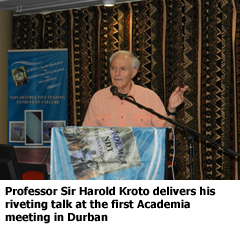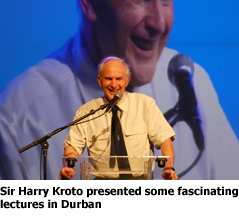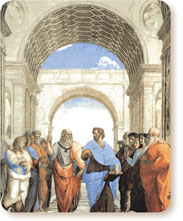Special Lecture Meeting - Durban, South Africa, April 2012
ACADEMIA Special Lecture Meeting
18 April 2012, Durban, South Africa
alongside 18th World Conference on NDT
Welcome Greetings
President: Giuseppe Nardoni
Lectio Magistralis
Academia NDT International was proud to host a series of two scientific meetings within the programme of the 18th World Conference on NDT held in Durban, South Africa from 16-20 April 2012. Both meetings featured keynote lectures by Nobel Laureate Professor Sir Harold Kroto.
The programmes for the meetings were as follows. Where available, the presentations may be downloaded by clicking the link-titles.
Session 1: Tuesday 17 April 2012
Chairs: Prof. Gerd Dobmann, Dr Baldev Raj (Vice President, Academia NDT)
1. "Nonlinear time reversal ultrasonics for NDT”, by Prof. Z Prevorovsky
2. “Nanotechnologies: material properties, technologies, applications", by Sir Harold Kroto
3. “Nanosensors “, by Prof. Mark Kreutzbruck
4. “Potential of TeraHertz radiation in NDT“, by Prof. U Ewert
5. Open discussion, social interaction.
All lectu
 res were met with great interest and were followed by enthusiastic discussion and all the participants
presented information that demonstrated new approaches to solutions of
the increasingly challenging tasks faced by scientists, specialists and
practitioners working in the area of NDT.
res were met with great interest and were followed by enthusiastic discussion and all the participants
presented information that demonstrated new approaches to solutions of
the increasingly challenging tasks faced by scientists, specialists and
practitioners working in the area of NDT. Dr. Z. Prevorovsky introduced new approaches used in ultrasonic testing, especially in the non-linear area and advantages of the use of recently developed Nonlinear Elastic Wave Spectroscopy (NEWS) as well as the technique referred as Time Reversal Mirror (TRM) for detection and evaluation of microcracks, bonds weakening, corrosion, etc.
After the presentation by the Nobel Prize Winner Prof. H. Kroto (see below), there followed an interesting presentation by Professor Marc Kreutzbruck informing participants about modern tendencies and practical use of this invention, in particular, carbon nanotubes.
The lecture by Professor Uwe Ewert was dedicated to new testing results in the field of operation in TeraHertz radiation range and comparison of newly emerging possibilities of this technique with traditionally implemented ultrasonic and radiographic methods.
For the full abstracts of all papers, download issue 4 of the Lectio Materia newsletter from here.
Session 2: Wednesday 18 April 2012
Chair: Giuseppe Nardoni (President, Academia NDT International)
"Research as a Key Stimulus of Economic Development" by Sir Harold Kroto
More than 120 people came to listen to this exciting presentation. In the auditorium you could see leading and well known scientists alongside young scientists and students at the very beginning of their scientific journey. Sir Harold is well known for his active position and impressive contribution in the process of involving young people in science and research works.
The lecture, which was entitled: “Scientific Research as a Key Stimulus of Socio-Economic Development” was humanitarian rather than purely technical. Everyone was called on to think about the future, about the importance of continuous development of science and research work for the prosperity of society, about the responsibility of each scientist for his/her work and activity, about the importance of promotion and clarification to those who are not very experienced or familiar or do not think how important it is to provide support and promotion of science, because the state and society cannot exist without science. He showed examples of how on the one hand there is total ignorance by politicians of the importance of science, while on the other the amazing enthusiasm of young people and their will to study if they have such an opportunity.
Prof. Kroto gave his lecture with such entertainment and enthusiasm that to everyone in the auditorium the 1.5 hour lecture passed like a minute. All participants thanked the Sir Harry with prolonged applause and afterwards he was surrounded by young scientists and students who continued to ask questions long into the evening.

Such a successful meeting arranged by Academia would not be possible without the enormous efforts of Academia President Giuseppe Nardoni. Participants of both meetings heartily thank him and the members of the Academia Council for their hard work.
Sir Harold (Harry) Walter Kroto, FRS is a British chemist and one of the three recipients to share the 1996 Nobel Prize in Chemistry with Robert Curl and Richard Smalley.
In the 1970s he launched a research programme at Sussex to look for carbon chains in the interstellar medium. The work led to led to the discovery of the C60 molecule - the spherical fullerene molecule known as the Buckminsterfullerene (or Buckyball). Buckminsterfullerene is the largest matter to have been shown to exhibit wave–particle duality. Its discovery led to the exploration of a new field of chemistry, involving the study of fullerenes.

